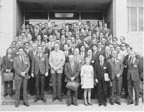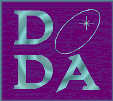You are here
History of the DDA
The Founding of the Division on Dynamical Astronomy; A Few Recollections on the Occasion of the 25th Anniversary
R. L. Duncombe, U. of Texas at Austin
(Pictures to be added)
The story of our Division must begin with Dirk Brouwer (picture A). He more than most others recognized the importance to Celestial Mechanics of the development of high speed computers and the burgeoning demands of the Space Age for trained personnel. Although he was not present to actually take part in the Divisions founding, it was his legacy through the Summer Institutes in Dynamical Astronomy which he started in 1959, and the Annual Seminars in Celestial Mechanics which he started in 1962, that provided the impetus for our division.
The opportunity to discuss current problems and solutions at length as provided by Brouwer's meetings contrasted so markedly to the occasional session with ten minute presentations allowed by the Astronomical Society that creation of a special interest group in Dynamical Astronomy seemed imperative. During the tenure of Dr. Whitford as President of the American Astronomical Society, and following some prodding by younger scientists, the bylaws were amended to allow the organization of such special interest groups within the framework of the Society. Dr. Martin Schwarzschild, as AAS Vice President, was delegated the task of dealing with the petitions.
By late summer of 1968, petitions for three divisions (hi-energy astrophysics, solar physics and planetary science) had been submitted an on 20 September, Dr. Samuel Herrick submitted a short proposal, prepared by Derral Mulholland, with fifteen signatures for a Division on Celestial Mechanics. This prompted the most thorough response (five and one half single-spaced typewritten pages) from Dr. Schwarzschild on 18 October 1968. At first reading, we thought perfunctory roadblocks were thrown up in the path of the petition, but on second reading we realized that he was asking for the information he required to convince the AAS council of the need for this division, e.g., why are the present meetings of the ASS inadequate to meet our needs; what sort of separate meetings have we had to resort to; can you list at least 40 people who would support such a division; is Celestial Mechanics a sufficiently encompassing title; can you furnish a list of a dozen people (around the age of 45) who would be willing to take on the work of organizing the division. In fact what he was giving us was a road map of the proper form for a petition.
Mulholland, with input from others, then produced the final petition meeting the above requirements; one important modification being a change of title from Celestial Mechanics to Dynamical Astronomy as being more representative of the interests involved (#1, list of original signers of the petition). This was sent to Dr. Schwarzschild in time to be presented to the AAS council at its December 1958 meeting. Supporting information regarding the types of programs initiated by Dr. Brouwer was provided by Victor Szebehely.
The AAS council looked favorably on the petition but membership of an organizing committee had still to be established. Dr. Schwarzschild asked Mulholland, Danby, Shapiro, and Duncombe to come up with candidates for this committee (#2, Schwarzschild letter). After telephone consultation, we produced a slate of names which he in turn relayed to the AAS council at its Hawaii meeting, where final approval for the Division on Dynamical Astronomy was granted. The organizing committee comprised: Danby, Duncombe, King, Kaula, Marsden, Shapiro, Szebehely, and Toomre. The next step was the drafting of the by-laws. Hank Gurin, recently appointed Executive Secretary of the AAS supplied the by-laws of the other three divisions as examples. The work of the organizing committee had been carried on mostly by mail and telephone but the Summer Institute in Dynamical Astronomy held at MIT in July 1969 afforded us the first opportunity to meet together (#3). The by-laws were finalized here and an announcement drafted inviting colleagues to join the new Division on Dynamical Astronomy (#4). Interest was heartening and the $2 entrance fee was a bargain; in the next four months the membership swelled to 98 (#5). But not everyone was happy as evidenced by this letter which I received.
Two important steps remained for the organizing committee: 1st) produce a slate of candidates for officers of the Division and conduct an election, and 2nd) decide on a place to hold the first meeting. The list of candidates was chosen according to the by-laws, with counsel from Dr. Schwarzschild and Mr. Gurin and an attempt was made to represent the various areas of interest represented by the Division. The choice of a place to hold the first Division meeting, however, was a tougher problem. We recognized that our treasury was practically empty. Could we find an already established and funded meeting in our area of interest that might allow us to be a co-sponsor? This would allow us to take part in the scientific agenda and permit us to hold a business meeting where the organizing committee could relinquish the reins to the first elected officers.
Dr. Szebehely came to the rescue with an invitation for the Division to hold its meeting jointly with the Eighth Annual Seminar on Current Problems in Celestial Mechanics at Austin, TX in late January 1970. Although several different opinions were put forth, a consensus was finally reached to accept Dr. Szebehely kind offer (#7). Later Tony Danby wrote somewhat wistfully, that although he agreed with the decision he had somewhat favored a spring meeting in Florida because he understood that Brian Marsden was willing to arrange for an eclipse of the sun at about that time. In the same vein he continued, "Incidentally, for the most sophisticated 'social' approach that I have yet to hear: B. Marsden to delicate young thing sitting next to him at a party: 'Would you like to have a minor planet named after you?'"
 The January 1970 meeting was a resounding success and the first business meeting of the Division was held. The duly elected officers now took responsibility for planning and operations. We had asked three of our elder statesmen, Drs. Clemence, Eckert, and Herget to be candidates to lend an aura of respectability to our new division (pictures of Clemence, Eckert, Herget) (#8, new officers). Plans had to be made for nominating committee and election of new officers prior to the next meeting.
The January 1970 meeting was a resounding success and the first business meeting of the Division was held. The duly elected officers now took responsibility for planning and operations. We had asked three of our elder statesmen, Drs. Clemence, Eckert, and Herget to be candidates to lend an aura of respectability to our new division (pictures of Clemence, Eckert, Herget) (#8, new officers). Plans had to be made for nominating committee and election of new officers prior to the next meeting.
Both Ivan King and Tony Danby pointed out, rightly so, that the composition of our Division Committee was not representative of the many interests of our Division and that this should be kept in mind in nominating the next slate of candidates. Danby was appointed chairman of the Nominating Committee. Since the January 1970 joint meeting had been such a success we asked Dr. Schwarzschild if we could meet jointly with the AAS at its winter meeting in Tampa. Dr. Schwarzschild said that current interpretation of AAS by-laws precluded simultaneous meetings of divisions with the parent organization. Later action by the AAS council, however, removed this obstruction and Dr. Schwarzschild then invited us to hold the next DDA meeting concurrently with the AAS in December 1970 with no charge for meeting rooms and other facilities. At this meeting Dr. Shapiro and the other new officers assumed control of the Division. It was during 1970 that the suggestion for a Brouwer Lecture Award was first proposed but action was not taken until 1971 with a Brouwer Fund Committee was established. I was asked to chair the committee. We immediately brought down the wrath of the AAS council on our heads by asking the AAS corporate members for money; the AAS was tapping into these same sources for their awards. Morris Davis later assumed charge of this effort and I believe he was successful in getting an award from the Perkin Foundation to reach the first goal of $2500. Since that time contributions have brought the fund to its present level of about $25,000. The series of Brouwer Lectures has been of exceptional quality as evidenced by the one we have heard today. Thus the story of the founding of the Division on Dynamical Astronomy begins and ends with Dirk Brouwer (picture #9).
Thank you for inviting me to talk about the early events in the history of the Division on this 25th anniversary of its founding. My thanks go out to all of my colleagues and friends who contributed so much to the development of the DDA. I am pleased with the exemplary way in the Division has grown and has performed, and I am proud to be a member. Congratulations on reaching the 25th anniversary and all good fortune in the coming years; call me up there or more likely, down there for the 50th. Thank you.
